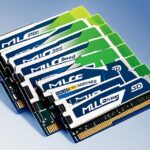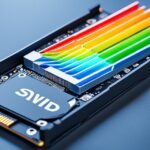Table of Contents
In our digital world, solid-state drives (SSDs) are key to how well our gadgets work. When SSDs get full, we may see big problems with how our devices perform. It’s very important to know how to troubleshoot an SSD, not just to find out why it’s full but also to better use storage and improve how our devices work. Finding answers to questions like “Why is my SSD so full?” can help us fix the problem. This guide looks closely at issues people often have with their SSDs. It offers advice on how to fix these problems and keep enough space on your SSD12.
Key Takeaways
- Identifying the reasons behind a full SSD can help in timely troubleshooting.
- Regular maintenance, such as deleting unnecessary files, can optimise storage space.
- Understanding SSD usage is crucial to prevent future storage issues.
- Utilising diagnostic tools can enhance performance by identifying potential problems early.
- Choosing the right SSD size tailored to your needs can significantly improve efficiency.
Understanding the Basics of SSDs
Solid-state drives (SSDs) are a big step forward in computer storage. They are much faster than old hard disk drives (HDDs). They can read data 10 times faster and write it 20 times faster. This is because they use flash memory. This allows for quick access times and makes them very durable.
SSDs use less energy, which means they save power. This is great for devices that use batteries3. They also handle heat better than HDDs. Because they have no moving parts, SSDs are more resistant to drops and bumps.
The introduction of NVMe (Non-Volatile Memory Express) has taken SSDs to a new level. NVMe SSDs can exchange data up to 2600 MB/s. That’s almost five times faster than SATA SSDs3. This technology speeds up data transfers. NVMe commands are also two times quicker than AHCI drivers. This shows how efficient SSD technology is4.
SSDs continue to evolve and become more important in technology4. They come in various shapes like M.2, U.2, and EDSFF. This makes them useful for many different uses. They lead the way in innovative computer storage solutions.
Common Symptoms of a Full SSD
A full SSD might show clear signs that there’s a problem with your system. You may notice your computer getting really slow, which can make it hard to do simple tasks. Another issue is when you can’t save or open files, leaving you unable to manage your data properly.
Booting up your computer might become tough, and you might see error messages. This can make your system less responsive. It could lead to it crashing or freezing often, disrupting your work. These issues could turn your SSD into read-only, making it even harder to use.
It’s very important to notice these signs early. Knowing about these problems can help you avoid losing data. It lets you keep your computer working well. Fixing these issues quickly can save you time and trouble later.
Why is my SSD so full?
Having a full SSD can lead to surprising storage problems. It’s key to figure out why it’s packed. Knowing about hidden files eating up space is part of solving the issue.
Identifying Hidden Files
Hidden files might be taking up more space than you realize. A user found 50 gigabytes of video on their SSD when they only thought they had 15 gigabytes. This shows that invisible files are there. By changing settings to see these hidden files, one can find out where space is going. Tools like Omni Disk Sweeper help uncover them5.
Checking Disk Usage
Knowing what eats up your SSD space is vital. Features like Get Info show which apps or files use the most space. Time Machine’s large local snapshots can also fill your SSD5. It’s also crucial to ensure the TRIM command is working. Without it, deleted files don’t clear out properly.
Keeping your SSD in top shape involves some effort. Check the BIOS settings and ensure the SSD is installed correctly. Issues like not setting SATA to AHCI could slow the SSD2. Understanding and managing disk space effectively helps avoid a full SSD.
Quick Fixes for Recovery
When your SSD is full, quick actions can help free up space. By deleting unnecessary files and using disk cleanup tools, you can enhance your SSD’s efficiency. This ensures your computer runs smoothly.
Deleting Unnecessary Files
Deleting files you don’t need should be your first move. Look in your Downloads folder, which often fills up with large, unneeded files. You can also get rid of temporary files, usually in %systemdrive%\Windows\Temp and %userprofile%\AppData\Local\Temp.
Removing apps you don’t use from your disk also frees up space. Remember, the Recycle Bin uses 5% of your disk space. Emptying it often aids in recovering SSD space efficiently6.
Utilising Disk Cleanup Tools
Disk cleanup tools, like Windows’ built-in utility, make it easier to clear space on your SSD. This utility lets you choose which files to delete, mainly removing temporary files and system caches safely. Using tools like EaseUS CleanGenius can further this process.
These help in finding and removing unnecessary files that fill your SSD7. Not only do they improve your SSD’s performance, but they also include features like scheduling cleanups to keep your disk space in check.
Optimising SSD Performance
To keep your SSD working well, it’s important to set it up right. Make sure you choose the correct settings for alignment and partition styles. This can really help boost how well it runs. One key thing is to enable the TRIM feature. This lets the SSD know which data blocks it doesn’t need anymore. It helps the SSD work better and faster when saving new data8.
Adjusting SSD Settings
Changing a few settings can greatly improve your SSD’s speed. SSDs work best when they’re not too full, ideally keeping 20% of space free. This helps your computer run more smoothly. Managing your disk space well can stop your SSD from getting slower over time8. It’s also a good idea to keep your SSD’s firmware up to date. Companies like Samsung, Western Digital, and Sabrent offer updates that can make your SSD faster9.
Ensuring TRIM is Enabled
Turning on TRIM boosts your SSD’s speed and longevity. With TRIM working, your SSD can manage its storage space more efficiently. This greatly improves performance. Making sure TRIM is turned on is key for anyone wanting their SSD to perform well. You might also think about turning off hibernation and system restore. These features use a lot of space and disabling them can help the SSD stay quick9. Although SSDs are faster than old hard drives, you need to manage them carefully to keep them speedy.
Long-term Solutions to Prevent Full SSDs
Keeping your SSD in good shape is key for its speed and lifespan. You should regularly check how much space you’re using. It’s also wise to keep 10-20% of your SSD free. This helps it work better for longer.
Understanding Storage Management
It’s important to keep an eye on what’s filling up your SSD. Cleaning out unneeded files and turning off system restore helps. You might also want to use an external drive or cloud storage for extra space1011.
Choosing the Right SSD Size
Choosing the right size SSD is crucial. They range from 128 GB to 8 TB for the bigger models12. Pick an SSD that fits your needs now and in the future. A quality SSD means less worry about running out of space1211.
Conclusion
It’s key to solve SSD challenges to keep drives working well. Understanding SSD basics and spotting when a drive is full help us fix problems. Using disk cleanup tools and removing extra files can improve storage space.
Also, it’s important to know that full SSDs slow down. They can be 6 to 10 times slower than drives that aren’t full13. Managing storage well keeps computers running smoothly and makes SSDs last longer.
By keeping an eye on storage and using suggested solutions, we can keep our systems fast and efficient. Adopting these methods helps use storage better and makes computing enjoyable14.
FAQ
What should I do first when my SSD is full?
First, look for files you don’t need, like duplicates or big downloads. Using tools like Disk Cleanup can quickly make room.
Turn on the setting to show hidden files on your computer. This lets you find data you didn’t know was filling up space.
What symptoms indicate that my SSD might be full?
If your system is slow, won’t boot properly, shows errors, crashes often, or the SSD becomes read-only, it might be full. Spot these signs to fix problems sooner.
How can I optimise my SSD’s performance?
For better SSD performance, make sure it’s set up right and use TRIM to manage space. This keeps your drive working well for longer.
What tools can I use for SSD space management?
You can use tools like Windows Disk Cleanup or EaseUS CleanGenius. They find and get rid of files you don’t need.
How much free space should I keep on my SSD?
Keep 10-20% of your SSD free. This keeps it running fast and lasts longer.
What factors should I consider when choosing an SSD size?
Think about how much space you use now and what you might need later. A bigger SSD avoids the hassle of running out of space.
Source Links
- https://www.techtarget.com/searchstorage/tip/4-causes-of-SSD-failure-and-how-to-deal-with-them – 7 causes of SSD failure and how to deal with them | TechTarget
- https://www.digitaltrends.com/computing/easy-ways-fix-ssd-not-showing-windows/ – SSD not showing up in Windows? Here are some easy fixes | Digital Trends
- https://kinsta.com/blog/what-is-ssd/ – What Is SSD? Everything You Need to Know About Solid-State Storage
- https://www.kingston.com/en/ssd/what-is-nvme-ssd-technology – What is NVMe SSD technology? – Kingston Technology
- https://discussions.apple.com/thread/6997645 – My SSD is full for no reason
- https://www.stellarinfo.com/blog/my-c-drive-is-full-without-reason/ – Fix Issue: My C Drive is full without reason
- https://www.easeus.com/partition-manager-software/free-up-recovery-disk-when-recovery-disk-is-full-in-windows-10.html – 6 Tips to Fix Recovery Drive Full in Windows 10/8/7
- https://www.kingston.com/en/blog/pc-performance/full-ssd-solutions – What to Do if Your SSD Is Full
- https://www.tomshardware.com/how-to/optimize-ssd-in-windows – How to Optimize SSD Performance in Windows 10 or 11
- https://www.easeus.com/computer-instruction/free-up-space-ssd.html – How to Free Up Space on SSD in Windows 10/8/7
- https://www.ibm.com/think/topics/hard-disk-drive-vs-solid-state-drive – Hard Disk Drive (HDD) vs. Solid State Drive (SSD) | IBM
- https://www.linkedin.com/pulse/maximizing-your-ssd-lifespan-how-ensure-long-term-reliability – Maximizing Your SSD Lifespan: How to Ensure Long-Term Reliability for Your SSD
- https://www.diskpart.com/windows-10/ssd-full-for-no-reason-0001.html – Effectively Solved: SSD Full for No Reason in Windows
- https://www.easeus.com/partition-manager-software/how-to-fix-ssd-full-for-no-reason.html – How to Fix SSD Full for No Reason








